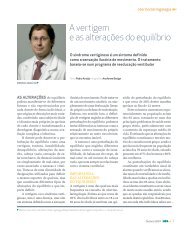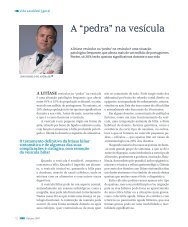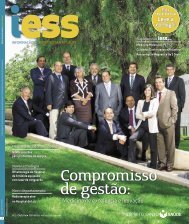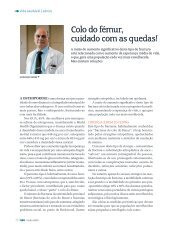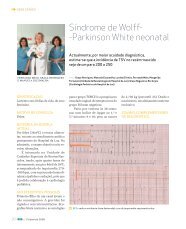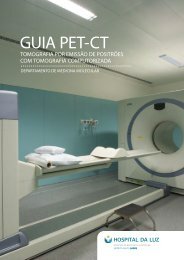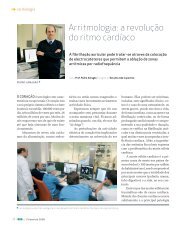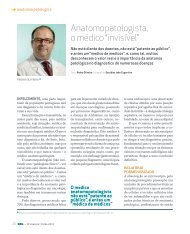Workflow contínuo – A revolução - Hospital da Luz
Workflow contínuo – A revolução - Hospital da Luz
Workflow contínuo – A revolução - Hospital da Luz
Create successful ePaper yourself
Turn your PDF publications into a flip-book with our unique Google optimized e-Paper software.
anatomia patológica<br />
completo até à impregnação. A grande<br />
evolução foi consegui<strong>da</strong> pela introdução<br />
<strong>da</strong>s microon<strong>da</strong>s na produção de<br />
temperaturas eleva<strong>da</strong>s, o que acelera<br />
todo o processo.<br />
Em termos práticos, verificou-se<br />
que durante o primeiro ano de trabalho<br />
com este método cerca de dois<br />
terços dos casos passaram a ser respondidos<br />
no mesmo dia, o que é uma<br />
mu<strong>da</strong>nça significativa quando compa-<br />
REFERÊNCIAS BIBLIOGRÁFICAS<br />
(1) Rosai J, “Why microscopy will remain a cornerstone<br />
of surgical pathology”. Lab Invest, 2007, 87: 403-408.<br />
(2) Mayers CP, “Histological fixation by microwave<br />
heating”. J Clin Pathol. 1970; 23: 273-275.<br />
(3) Boon ME, Walls-Paap C, Visioni F et al. “The two<br />
step vacuum-microwave method of histoprocessing”.<br />
Eur J Morphol. 1995; 33: 349-358.<br />
(4) Visioni F, Milios J, Leong AS-Y et al.<br />
“Ultra-rapid micro-wave/variable pressure induced<br />
histoprocessing description of a new tissue<br />
processor”. J Histotechnol. 1998; 21: 219-224.<br />
(5) Morales AR, Nassiri M, Kanhoush R, Vincek V,<br />
Nadji M. “Experience with an automated microwave-<br />
-assisted rapid tissue processing method”. Am J Clin<br />
Pathol, 2004; 121 (4): 528-536,.<br />
(6) Vernon, E Stephen. “Continuos throughput rapid<br />
tissue processing revolutionizes histopathology<br />
workflow”. Lab Med. 2005; 36 (5): 300-302.<br />
(7) Leong, ASY . “Microwaves and turnaround times in<br />
histoprocessing. Is this a new era in histotechnology?”.<br />
Am J Clin Pathol, 2004; 121: 460-462.<br />
16 iesspro Outono 2007<br />
ra<strong>da</strong> com um valor de 1% antes <strong>da</strong> introdução<br />
do processador rápido [14].<br />
Durante cerca de três anos os autores<br />
compararam os resultados obtidos<br />
com o novo método com a quali<strong>da</strong>de<br />
dos tecidos processados segundo as<br />
metodologias convencionais [5].<br />
As conclusões mais importantes<br />
referem-se ao facto de terem constatado<br />
que as novas tecnologias não alteravam<br />
a quali<strong>da</strong>de <strong>da</strong>s secções his-<br />
(8) Rohr LR, Layfield LJ, Wallin D, Hardy D.<br />
“A comparison of routine and rapid microwave tissue<br />
processing in a surgical pathology laboratory. Quality<br />
of histologic sections and advantages of microwave<br />
processing”. Am J Clin Pathol. 2001 May;<br />
115 (5): 703-708.<br />
(9) Leong AS. “Microwave fixation and rapid<br />
processing in a large throughput histopathology<br />
laboratory”. Pathology. 1991 Jul; 23 (3): 271-273.<br />
(10) Emerson LL, Tripp SR, Baird BC, Layfield LJ, Rohr<br />
LR. “A comparison of immunohistochemical stain<br />
quality in conventional nd rapid microwave processed<br />
tissues”. Am J Clin Pathol. 2006 Feb; 125 (2): 176-183.<br />
(11) Stanta G, Mucelli SP, Petrera F, Bonin S, Bussolati<br />
G. “A novel fixative improves opportunities of nucleic<br />
acids and proteomic analysis in human archive’s<br />
tissues”. Diagn Mol Pathol. 2006 Jun; 15 (2): 115-123.<br />
(12) Olert J, Wiedorn KH, Goldman T, Kuhl H, Mehraein<br />
Y, Schertan H, Niketeghad F, Vollmer E, Muller AM,<br />
Muller-Navia J. “HOPE fixation: a novel fixing method<br />
and paraffin-embedding technique for human soft<br />
tológicas quando compara<strong>da</strong>s com as<br />
obti<strong>da</strong>s pelo processamento convencional,<br />
havendo até uma melhoria no<br />
respeitante a alguns detalhes <strong>da</strong> morfologia<br />
nuclear [5, 13]. Também os métodos<br />
histoquímicos e imunocitoquímicos<br />
clássicos, quando aplicados às<br />
amostras processa<strong>da</strong>s pelos novos métodos,<br />
produziam resultados de igual<br />
quali<strong>da</strong>de, dispensando recuperação<br />
antigénica no caso de alguns anticorpos,<br />
visto a exclusão de formaldeído<br />
do sistema reduzir a modificação antigénica<br />
habitualmente atribuí<strong>da</strong> àquele<br />
fixador [5, 10, 15].<br />
NOTA FINAL<br />
Será que estamos a assistir a uma nova<br />
era na área <strong>da</strong> histotecnologia?<br />
O que sabemos e experimentamos no<br />
dia-a-dia diz-nos que um processador<br />
rápido de tecidos num laboratório<br />
de anatomia patológica obriga a<br />
mu<strong>da</strong>nças importantes na prática <strong>da</strong><br />
especiali<strong>da</strong>de. Podemos concluir que as<br />
novas tecnologias mostram capaci<strong>da</strong>de<br />
para alterar de forma radical o modo<br />
como se trabalha na área do diagnóstico<br />
anatomo-patológico de rotina [6].<br />
tissues”. Pathol Res Pract. 2001; 197 (12): 823-826.<br />
(13) Morales AR, Nassiri M, Kanhoush R, Vincek V,<br />
Nadji M. “Experience with an automated microwave-<br />
-assisted rapid tissue processing method: vali<strong>da</strong>tion<br />
of histologic quality and impact on the timeliness of<br />
diagnostic surgical pathology”. Am J Clin Pathol.<br />
2004 Apr; 121 (4): 528-536.<br />
(14) Morales AR, Essenfeld H, Essenfeld E, Duboue<br />
MC, Vincek V, Nadji M. “Continuous-specimen-flow,<br />
high-throughput, 1-hour tissue processing. A system<br />
for rapid diagnostic tissue preparation”. Arch Pathol<br />
Lab Med. 2002 May; 126 (5): 583-590.<br />
(15) Nadji M, Nassiri M, Vincek V, Kanhoush R, Morales<br />
AR. “Immunohistochemistry of tissue prepared by a<br />
molecular-friendly fixation and processing system”.<br />
Appl Immunohistochem Mol Morphol. 2005 Sep;<br />
13 (3): 277-282.<br />
(16) Vincek V, Nassiri M, Nadji M, Morales AR. “A tissue<br />
fixative that protects macromolecules (DNA, RNA,<br />
and protein) and histomorphology in clinical samples”.<br />
Lab Invest. 2003 Oct; 83 (10): 1427-1435.



